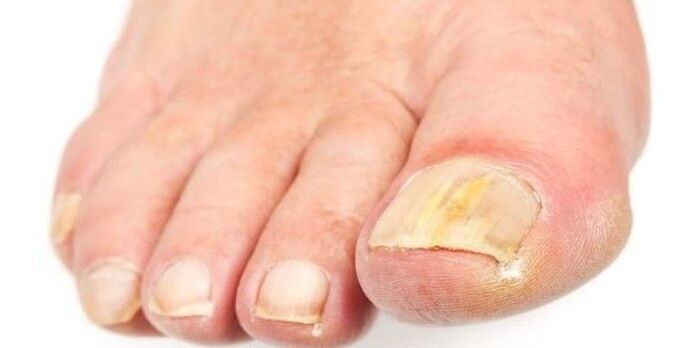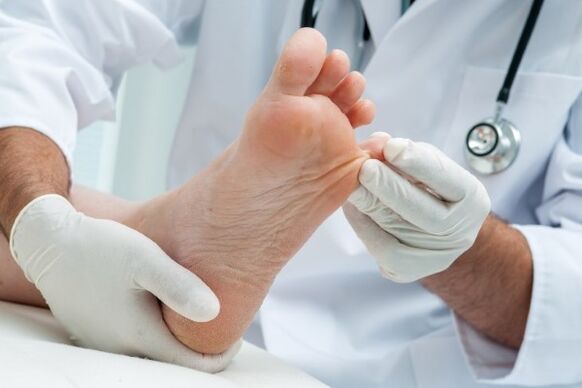The fungus, also known as onychomycosis, is an infection on the surface of the nail caused by dermatophytes, yeast or mildew.
The color of the nails changes, it first acquires a whitish shade, then a darker and can smell bad. He plays, deforms, begins to fall apart.
The infection is likely to spread to other toenails and adjacent skin. The soreness will appear when walking, wearing shoes. Therefore, the fungi should be processed on time.
The causes of onychomycosis are quite banal:
If there are irritations, the legs sweat a lot and the shoes are packed and slightly ventilated for long periods of time - this is an ideal environment for the growth of the dispute.
The most common symptom caused by a fungal infection is the thickening of the plate. The nail can be avoided to have white, black, yellow or green.
With the development of the disease, it becomes fragile, small pieces of nails break or can be completely separated from the finger. If you do not pay due attention, the skin under it is swollen, becomes painful, flaky. An unpleasant odor arises
If the disease does not work, there are usually no other symptoms. Sometimes the body can respond to the fungus in the skin without damage. A rash or itching caused by dermatophytes can be an allergic reaction of the body to a fungus.
Everyone may have a toe infection, but there are certain risk factors that make a person more proposed to infection with fungal nails. Some of them are as follows:
Severe foot infection can be very painful and lead to constant damage to your nails. If a person has a depressed immune system, diabetes or other chronic disease, there is a high risk of complications. In diabetes, blood circulation decreases and neuropathy often occurs. Sometimes you can't perceive pain.
Thus, not only the nail sponge, but any slight injury of the legs can be a serious problem. If a person has diabetes and thinks there is an infection, it is wise to see a doctor.
The infection of the nail sponge is sometimes incorrectly diagnosed as psoriasis, contact dermatitis and tumors, such as melanoma. Laboratory tests may be required to avoid improper diagnosis.
As a rule, three approaches are used:
These three approaches use microscopic tests of the nail material obtained by scrapers or trimming.
According to some recent improvements, in terms of sensitivity, the most helpful are direct shocks, histological examination and nail biopsy, using the spoon of periodic acid of the Schiff.
Several samples may be required to diagnose the organisms of the sponge properly.
The first step that can be taken to prevent fungal infections of the legs is the observation of proper hygiene. Pure and dry legs definitely prevent any fungal infections.
Perform regular soap washing and be sure to dry them after the procedure. You should wear shower slippers in public places.
You may need to change shoes, socks and underwear more than once a day.
Improve the nail cutting technique - cut them so that your nails do not exceed your feet.
You may need to wear shoes that do not fit tightly to your fingers and their material should be such as to provide ventilation.
Avoid wearing cotton or wool socks. Prefer socks made of special synthetic fibers that absorb moisture from your feet more efficient than cotton and wool.
Drink nails and tools for pedicure. Do not use nail polish that have an infection.
It is worth arranging an appointment with your doctor if your fungal nail infection causes signs of bacterial: you should check the list of signs and symptoms of the correct diagnosis and the right choice of medicines.
The doctor will examine the patient, listen to complaints, after which the primary tests are performed by collecting biomaterial to determine the type of fungi. Then a complete analysis of the results and purpose of therapy.
If the fungal infection is mild, there is no need for complex treatment. However, ignoring can lead to its spread to other nails. Below are available options for treatment for nail fungus:
Medicines are usually recommended when fungal nail infection is serious.
You may need to take the medicine for several months so that the infection has gone. Stopping the drug will relapse too early. Some side effects of medicines may include headaches, itching, loss of taste, nausea and diarrhea.
If a person does not want to take pills, the doctor will advise to use nail polish instead. It is not as effective as oral products because it cannot always penetrate deep into the nail to the focus of the infected area. Terms of use reach 12 months.
An abnormal -looking nail can be removed chemically with a paste containing 40% urea. The pasta is easily accessible in pharmacies. You need to attach it to the nails, cover it and leave it overnight. Rinse the pasta in the morning and repeat the procedure daily. The infected plate will dissolve in about 2 weeks.
This is a painless treatment option that removes the patient with the nail and also gradually eliminates mycosis. With such treatment, it is not necessary to take pills for several months and to avoid surgery.
Surgery to remove an infected nail is only recommended for difficult conditions if it becomes very painful and other methods of treatment have not helped. After the surgery, the nail will start to grow again, but it may be necessary for a year for full recovery.
In the case of persistent nail infection, laser treatment is possible. The laser emits high doses of light energy that kills and destroys the sponge.
According to studies, laser therapy is completely safe and the treatment rate is 90% after 3 months. However, this requires repetition every three months of the year and is not cheap.
Treatment for nail infection can be a long and expensive process.
The perioski drugs have been working on average about four months, while the infected nail is replaced with healthy ones.
When you use antifungal nail polish, the duration of treatment increases and can take about a year.
Laser and surgical removal provide faster results.
















